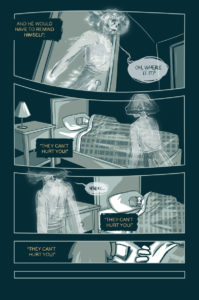The good and bad news is that the indie comic space has exploded of late. We now have more and more diverse creators pushing the medium beyond mainstream fare. But the hitch is that it is harder than ever for quiet, thoughtful voices to be heard amid the clatter of retro-space adventures and revisionist historical thrillers. Kristin Tipping is one such voice. Tipping creates touching pieces tinged with horror elements, cute animals, and queer feelings. But, mostly, I think, she writes about emotions and relationships — whether it be the passion shared between monsters and humans, bonds between pets and owners, or the melancholy struggle among friends growing up in an eerie mid-American town.

A comicbook and art fan from childhood, Tipping developed her evocative style as a graduate student in illustration at the Minneapolis School of Art and Design. You can see in her spare dialogue and paneling technique the influence of Emily Carroll. And the work of Junji Ito is clear in her fondness for subtle, slow-burning horror tropes. The result is an endearing rumination on why we feel what we feel, and how feelings of dread, regret, and loneliness make us human (or animal). Because, if her Evil Witch Allie and A Book for Sad Pets are any indication, this creator wants us to be okay with who we are and to understand that, despite the anxieties and insecurities of life, we are not alone.
Here are some thoughts on the challenges of self-publishing, the creative process, and what corporate comics can do better. She’s tabling at the Chicago Alternative Comics Expo on June 1 and 2. Be sure to drop by and say hello.
RP (Rogues Portal): Tell us about your latest project. How did it come about?
KT (Kristin Tipping): I’m nearing the end of volume two of my web comic, Evil Witch Allie. The story follows a group of ‘tweens’ as they (literally and metaphorically) try to survive growing up in a small, increasingly haunted Midwestern town. The series began as my thesis project in graduate school, and it sort of just kept expanding after that. I expect the full series to be four or five volumes in total.
RP: What inspired you to make comics?
KT: I love visual art and I love stories. So, it just seemed like a natural fit. I’ve always enjoyed reading comics, and I’ve been drawing since childhood. When I started writing stories, this seemed like a good way to tell them.
RP: Who do you admire, past or present, working in comics?
KT: A bunch of people! If you want me to narrow it down to a few examples, though, I’m a huge fan of Eleanor Davis, Emily Carroll, Nagata Kabi, and Junji Ito.
RP: Animals are a recurring theme in your work. What about the subject interests you?

KT: I never intended to make so many comics that prominently feature animals (and especially pets). But there’s clearly something that I find compelling about them. I think part of it is that I just like drawing cute things. ^-^; But I also find them kind of fascinating. We have such affection for our pets, but how they think and experience the world will always be a partial mystery to us because they can’t communicate with words.
RP: What mark do you want to make on comics that have LGBTQ and/or non-binary themes?
KT: I’m more interested in making interesting comics about characters that happen to be queer than I am in making Queer Comics™. We definitely need more comics that put queer issues front and center. But I think we also need more comics where queer characters are allowed to just be people. My queerness informs who I am, but it’s still only one facet of my identity, and I want it to be the same for my characters.
RP: What are the blessings and curses of indie comic publishing?
KT: The good part is that nobody cares what you make, and the bad part is that nobody cares what you make. You have total freedom to write whatever you want. At the same time, though, there’s such a glut of content out there. It’s extremely hard to get noticed.
RP: Tell us about your creative process.
KT: With shorter comics, I’ll sometimes write out all the copy in stream of consciousness. But, most of the time I start by making a bullet list of the basic plot points. From there, I’ll break the story down into scenes and then into an actual comic script. It is the only way I’ve found to stop myself from veering off into a thousand random tangents that contribute nothing to the story.
I’ll often work on the concept art at the same time that I’m scripting. But, I don’t usually start working on final pages or even the layouts until the script is mostly done. Sometimes, I’ll drop a concept and then come back to it three or four different times before it turns into anything worthwhile.
RP: What would you like to see corporate comics do differently?
KT: Pay all the people making their comics a living wage.
RP: The floor is yours. Tell us anything you want us to know about yourself or your comics.
KT: If you’re interested in seeing more of my work, please go to kristintippingillustration.com.
You can find all of my comics on Amazon. My newest book, A Book For Sad Pets, is also available on Amazon, and you can buy it from most booksellers.
And, you can support me on Patreon at patreon.com/kristintipping. There, you can get early access to comic pages and sneak peeks of in-progress art.
Nine Questions is a regular feature at Rogues Portal that spotlights a self-published comic creator. If you are an indie writer and/or artist who would like to be interviewed for this column, contact us at info@roguesportal.com.

![[PODCAST] FANBOY POWER HOUR 246: ALL HAIL THE KING](https://geekd-out.com/wp-content/uploads/2019/06/FanboyBanner-150x150.png)

